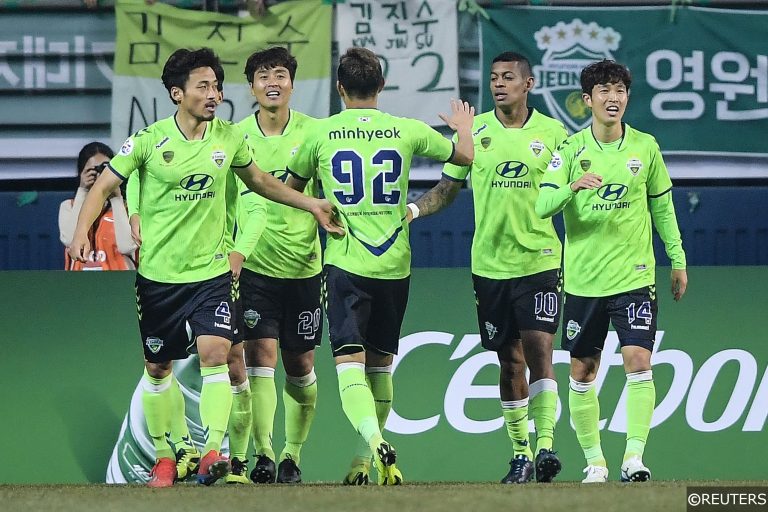All you need to know about the South Korea K-League 1 2020 season

Born in the south east of Ireland, Simon put his life-long love of football to good use when he started a successful independent blog in 2010. That opened up an alternative route to a career in journalism, and having had work published across a number of sites and publications, Simon joined the staff at Spotlight Sports Group in 2018.
Football across the globe is inching towards a return, and while many of the world’s domestic leagues are still taking tentative steps towards normality, others are just about ready to go.
Friday May 8th sees the launch of the new South Korean K-League 1 2020 season, and there is plenty to sink your teeth into in terms of betting markets and action in the South Korean top-flight.
While the game on the Korean peninsula might be unfamiliar to many of you, the return of more live football action should help to fill the void until more of the mainstream leagues return.
To help you separate your Gangwon from your Gwanju, we’ve put together a K League 1 guide, complete with key information, statistics and the players and teams to watch in the upcoming season. We’ll also be providing regular South Korea K-League predictions and betting tips.
Check it out below.
South Korea K-League 1 format
Important schedule change
During a normal season in the 12-team South Korean elite division, clubs usually play against each other three times before the league is ultimately split into its “championship” and “relegation” stages after 33 rounds of fixtures.
From there, the top six teams play off for the league title, while the bottom six engage in a battle for survival. The club that finishes last is relegated outright to K League 2, though the side that places second from bottom is given one last chance to retain their status in a play-off contest against the second tier’s runner up.
However, the 2020 campaign will operate a little differently. With less time and a shorter schedule to deal with, teams will play each other twice instead of three times this year before splitting into their Championship and Relegation groups.
In line with the government’s social distancing guidelines, all fixtures will be held behind closed doors for now, though that could change as quarantine restrictions are relaxed later this year.
Continental qualification and relegation
The K League 1’s top two secure qualification for the AFC Champions League, while third place can make the same continental competition through the preliminary rounds.
Don’t back Sangju Sangmu to make the AFC Champions League however! They are a military team and are not eligible to represent South Korea in the AFC club competitions.
Sangju Sangmu also complicate the relegation format a little this year. With the expiration of the agreement between K League, the Armed Forces Athletic Corps (Sangmu) and Sangju City in 2020, both a relocated Sangmu club and a Sangju citizen team will participate in K League 2 from 2021.
That means that Sangju Sangmu will automatically drop out of the division this term, however, if they don’t finish last this season – two teams will be automatically relegated. Sangju Sangmu will exit the league and and the team that finishes bottom of standings will join them.
Teams to watch in 2020
Jeonbuk Motors
Jeonbuk Motors finished second during the regular 2019 season, but snatched glory ahead of Ulsan Hyundai in the Championship Round on goal difference. The Green Warriors’ triumph was their third on the spin and their fifth title win in six seasons.
Manager Jose Morais has been busy in the transfer market in his attempts to retool his squad ahead of another run at the championship.
2019 MVP nominee Moon Seon-min has gone to Sangju Sangmu to complete his national service, while the equally important Ricardo Lopes has jumped ship to China, joining Super League outfit Shanghai SIPG.
To fill the gaps, Morais brought in South African international striker Lars Veldwijk, experienced centre-back Oh Ban-suk and reigning league MVP Kim Bo-kyung from Kashiwa Reysol, who starred for runners-up Ulsan Hyundai on loan last year.
Young poacher Cho Gue-sung is another player to keep an eye on. The striker scored 14 times in his first professional season with FC Anyang last year.
Ulsan Hyundai
Last year’s runners up Ulsan will be determined to go one better this time around, and after some shrewd looking off-season transfer business, they look well equipped to make that final push for silverware.
Former Bolton Wanderers and Crystal Palace employee Lee Chung-yong should add some real quality to their team, while stopper Cho Hyun-woo, who performed heroically for the South Koreans at World Cup 2018, adds class between the sticks.
In 33-year-old Junior Negao, Ulsan also have one of the K League 1’s deadliest finishers. The Brazilian scored 19 times in 2019 and is capable of hitting similar numbers in 2020. Negao will be joined up front by Björn Johnsen this season – the Norwegian who has tons of European football experience signed for Ulsan from AZ in the Netherlands.
Pohang Steelers
After consecutive 4th place finishes in 2018 and 2019, Pohang Steelers will be aiming a little higher this term.
Steelers improved massively in the second half of the 2019 campaign under new coach Kim Ki-dong, and with successful mid-season signings Stanislav Iljutcenko and Aleksandar Paločević ready to produce the goods in their first full year with the club, Pohang are dark horses to follow in this year’s title race.
Winger Manuel Palacious and fullback Kim Sang-won were also both drafted in from FC Anyang after superb K League 2 campaigns last year, and we think both players are ready to make a splash in the top tier.
With five K League 1 and three AFC Champions League titles, Pohang Steelers have a silver-lined history, and they look better equipped than they have in quite a while to rejoin the K-League’s elite this season.
Players to watch
Kim Bo-kyung (Jeonbuk Motors)
Voted the MVP for K League 1 last season, midfielder Kim Bo-kyung enjoyed a fantastic campaign for Jeonbuk Motor’s nearest rivals Ulsan in 2019, notching 13 goals and nine assists from the middle of the pitch.
The 30-year-old, who was on loan from Kashiwa Reysol in the Japenese J-League, played a key role in Ulsan’s major title charge last term, so his decision to sign for Jeonbuk during the transfer window caused quite a stir.
Kim Bo-kyung spent three years in England between 2012 and 2015, first with Cardiff, where he played under Ole Gunnar Solskjaer in the Premier League, and then with Wigan in the Championship, before he moved back East.
Adam Taggart (Suwon Bluewings)
Australian centre-forward Adam Taggart hit the ground running in his first season in South Korean football in 2019, scoring a whopping 20 goals in 33 league appearances during a sparkling debut year for Suwon Bluewings.
Now that the 26-year-old is fully integrated, his output could potentially increase, especially if he can build on his promising on-pitch relationship with his compatriot and midfielder Terry Antonis.
Taggart has also been making waves at international level and has scored three times in his last four games for the Socceroos.
Aleksandar Paločević (Pohang Steelers)
Serbian schemer Aleksandar Paločević joined Pohang Steelers from Portuguese Primeira Liga side C.D. Nacional in mid-season in 2019, and the 26-year-old immediately looked a class apart.
Paločević’s arrival and subsequent performances helped the Steelers to finish their league programme with a positive burst, and the attacking midfielder’s influence should be equally significant in his first full year in South Korea.
Lee Chung-yong (Ulsan Hyundai)
Known in his homeland as the “Blue Dragon”, fans of England’s Premier League should be familiar with Lee Chung-yong from his time with Bolton Wanderers and Crystal Palace.
Still only 31, the midfielder has long been a national team fixture too, and Lee represented South Korea at both the 2010 and 2014 World Cup, amassing 89 caps in total during his lengthy international career.
Lee’s move to Ulsan represents a real coup for last year’s K League 1 runners up, and his quality and experience could make all the difference for the South Coast giants this season.
Cesinha (Daegu)
Voted the best midfielder in the K League 1 last season, Brazilian Cesinha had been tipped to leave Daegu in the off season, though his decision to stay with the Sky News was a massive boost ahead of the new campaign.
The 30-year-old arrived in South Korea as a relative unknown in 2016, though the Corinthians academy graduate didn’t take long to establish himself as one of the K League 1’s most influential players.
Cesinha scored 11 times in 26 league run outs for Daegu in 2019, and caretaker manager Lee Byunggeun will be hoping for more of the same in 2020.
More FST News:
When will football return? State of play in Europe’s top leagues
What football is still on this week?


